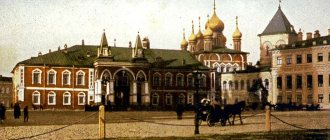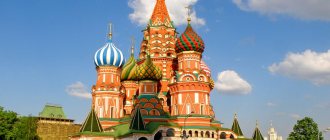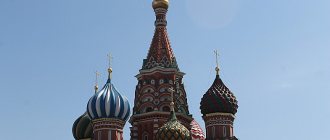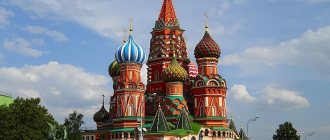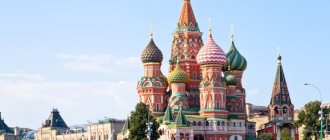Fools... People who embarked on this difficult path deliberately presented themselves as insane, neglected all worldly goods, humbly endured a hail of endless ridicule, contemptuous attitude, and various punishments from those around them. Using an allegorical form, they tried to find a way to people's hearts and souls, preached the ideas of goodness and mercy, exposed deception and injustice. Not everyone was able to suppress the beginnings of pride, ignore the needs of the body, and become spiritually superior to those around them. One of those who managed to do this is Blessed Basil, the most famous and revered holy fool. Our material is about him.
Saint Basil: life
His life journey is amazing from day one. December 1469. Dates vary, and some sources give 1464. A simple woman named Anna appears on the porch (Epiphany Cathedral in the village of Elohovo). She came here with prayers for the safe birth of the child. The woman’s words were heard by the Mother of God. And in the same place, Anna gave birth to a boy who received the name Vasily (Vasily Nagoy - that’s what they also call him). A pure soul and an open heart are what he came into the world with.
His parents, from among simple peasants, were distinguished by their piety, revered Christ, and built their lives according to his commandments. From an early age, they sought to instill in their son a respectful and reverent attitude towards God. Blessed Vasily was growing up, and, dreaming of a good life for his son, his father and mother decided to introduce him to shoemaking.
Work as an apprentice
The young apprentice was distinguished by his hard work and obedience. He would have worked for so long if not for one amazing incident, after which his master realized what an extraordinary person Vasily was. One day a merchant appeared in the workshop with a request to make such boots that they would not need to be demolished for a whole year. Blessed Vasily, shedding tears, promised him shoes that he would never wear out. The student later explained to the bewildered master that the customer would not even be able to put on the ordered pair; he would soon die. Very little time passed and these words came true.
An infantile teenager or an exposer of lies?
There are so many cases now where sixteen-year-old teenagers mindlessly break car windows, damage things, and try to “express themselves” through provocative clothing and hairstyles.
At first glance, Saint Basil, at 16, sometimes seemed like young infantiles: he walked around informally dressed in rags and chains (or undressed), acted outrageously in public places - he threw rolls from the counters at the market, poured kvass from the jugs of traders.
The sellers' response was not late: in a rage, they beat the blessed one with anything they could find, mistaking him for a madman. But later it turned out that the products that the saint knocked over were unfit for consumption: spoiled, or even poisoned.
And the merchants understood that this was not a fool, but a real holy fool, a saint, who hides his help behind ugliness, protects them from disrepute, and takes beatings himself.
The way to Moscow
After this incident, Vasily decided to part with shoemaking and spend his life following the thorny path of foolishness. Until his death, he lived without any savings, unprotected from ridicule or insults, having only an invisible amulet - faith and all-encompassing love for God. All his clothes were chains.
Vasily, leaving his parents, went to Moscow. At first, the people perceived the strange naked guy with surprise and ridicule. But soon Muscovites recognized him as a man of God, a holy fool for Christ’s sake.
Saint Basil: miracles
People, usually not understanding his strange actions, became angry. Only later did their secret meaning become clear. Once, having deliberately scattered the rolls at one of the merchants, Vasily meekly endured the curses and beatings rained down on him. Later, the unlucky kalachnik confessed to adding lime and chalk to the dough.
Other miracles of St. Basil are also known. One day a merchant approached him: the vaults of the church he was building had collapsed three times for unknown reasons. The Moscow holy fool advised him to find poor Ivan in Kyiv. Having done this, the merchant found a man in a poor house rocking an empty cradle. The merchant asked what this meant. The poor man explained that in this way he decided to pay tribute to his mother. It became clear to the unsuccessful “builder” why Vasily sent him here. After all, even earlier he drove his mother out of his home. Without repenting of what he had done, he dreamed of glorifying the Almighty with the built temple. The Lord refused to accept a gift from a person who was low in soul. Blessed Basil was able to help this man: he repented, made peace with his mother, and the woman forgave him. Then the construction of God's temple was successfully completed.
What miracles and prophecies did he become famous for?
The miracles of St. Basil's lifetime were famous throughout Rus'.
- Once invited to a royal feast, he did not drink wine, but poured it out the window three times. When asked by Tsar Ivan the Terrible why he did this, the elder replied that in this way he extinguished the fire in Novgorod. It was soon confirmed that on that day a large fire occurred in the mentioned city, and it was extinguished by a strange naked man walking through the streets and sprinkling the burning houses. Everyone was incredibly surprised when witnesses to the events described recognized him as St. Basil the Blessed.
- When the Saint passed by the Prechistensky Gate, he noticed a demon who took the form of a beggar and asked for alms. At the same time, he tempted people, promising quick help to everyone who gave him, and pretended that he was really praying for them. Realizing the cunning of the demon, the Blessed One began to loudly shout at the servers and call them self-seekers. Then he drove the cunning demon out of the city forever.
- One Moscow rich man decided to help the holy fool and gave him a warm fur coat. Vasily, who disapproved of luxury, did not want to accept it for a long time. The compassionate boyar convinced him of his sincerity and deep faith in Christ, after which the Blessed One nevertheless accepted his gift. Thieves immediately coveted the donated fur coat. To appropriate it, one of them pretended to be dead and lay down in the middle of the road. The rest began to ask Vasily for alms for the burial of their comrade. The saint immediately understood their deception, but took off his fur coat, covered the “deceased” with it and said: “May you be truly dead from now on, since, not fearing God, you wanted to accept alms by deception.” Sighing heavily and crying, he went his way. The thieves' joy at easily appropriating an expensive fur coat immediately disappeared when they saw that their accomplice had actually died. After this, they stopped engaging in fraudulent activities and left the place where the described events took place.
- In the summer of 1521, anticipating an attack by the Mongol-Tatars, Vasily prayed tirelessly for the salvation of the capital of Rus'. After some time, the invasion he foresaw happened: the Crimean Khan approached the walls of Moscow and began to prepare for the invasion of the city. Soon the enemy troops retreated, frightened by the approach of a huge Russian army. People considered this event a real miracle that happened thanks to the intercession of the Blessed Elder.
Vasily also became famous for his prophecies, many of which were destined to come true. In 1547, he predicted a major fire that destroyed a significant part of Moscow. The Blessed One also prophesied the reign of Peter the Great, the destruction of Orthodox churches and their subsequent revival. Interpreters of the holy elder’s predictions believe that from contemporary events he foresaw the Chechen War, the era of Boris Yeltsin’s reign and other important events for Russian history.
Further manifestation of the gift
St. Basil, whose short biography has reached us, always abstained from pleasures, humbly endured the hardships of his existence, lived on the street among a large number of people, and patiently endured all hardships. At the same time, his soul remained innocent and bright. Over time, his gift manifested itself with increasing power.
With the help of the Almighty, Blessed Basil, the Moscow miracle worker, was able to predict the invasion of Moscow. The situation was like this: he, as usual, was praying at night, when a sign appeared - flames that burst out of the church windows. Vasily’s prayers became more zealous. Gradually the fire died out. Some time after this incident, the Crimean Tatars attacked the Nikolo-Ugreshsky Monastery and the villages nearby; they were plundered and burned, but Moscow remained untouched.
The next wonderful event. 1543 July. St. Basil is again visited by a vision that predicted a strong fire: a number of streets were burned out, the disaster affected the Holy Cross Monastery, the Tsar's and Metropolitan's courtyards.
One winter day, one boyar managed to persuade the holy fool to accept a gift from him - a fur coat. After much protest, Vasily agreed. Walking in this fur coat, he met a gang of thieves. Those, fearing to take away their clothes by force, were not too lazy to put on a real performance in front of the revered holy fool. One pretended to be dead, others began to beg for a fur coat, supposedly to cover their deceased friend. The holy fool, covering the pretender, asked if he was really dead. The thieves assured him of the veracity of what had happened. St. Basil's wish in response to their response was to punish hypocrisy. After he left, the thieves literally froze - their comrade no longer needed to pretend, he actually died.
All his life the holy fool helped people and sympathized with them. Moreover, absolutely everyone. Especially those who were ashamed to ask for help. So, he gave the gifts he received from the king to a foreign merchant. He lost money and went hungry for more than one day. He did not ask for help - he was ashamed of his rich clothes.
Vasily was a frequent visitor to Kitay-Gorod. He went to the correctional prison for drunkards located there. Encouraging words and exhortations are what he used to help depressed people return to a normal lifestyle.
With affection and prayer
Moscow wonderworker Blessed Basil. Artist Vitaly Grafov, 2005. Image from bankgorodov.ru
How often can you hear sharp words of condemnation addressed to those people who have lost their way in life: this guy like that, drinks, doesn’t work, just sits in front of the computer... But anger and condemnation cannot correct human vices...
The blessed one often approached taverns, where he spoke kindly with those who had “descended” and tried to instill hope in them.
And it helped many people return to normal life. Of course, behind the saint’s affection was his fiery prayer, which quickly reached God.
And if a saint happened to pass near a house from which the sounds of drunken festivities and abuse were heard, he hugged the corner of this house and cried. When the blessed one was asked to explain why he hugged the corners of taverns, he said: “Sorrowful angels stand at the house and lament over human sins, and with tears I begged them to pray to the Lord for the conversion of sinners.”
The attitude of Ivan the Terrible to the holy fool
St. Basil, whose life we continue to consider, lived under two autocrats. Reverence and fear - these were the feelings with which one of them, Ivan the Terrible, treated him. The man of God, whom he saw in the holy fool, was for the king a constant reminder of the need to live fairly and not skimp on good deeds and deeds.
Having encountered several cases, Ivan the Terrible became convinced that we were actually talking about a pious holy fool, detached from worldly affairs. One day, St. Basil the Blessed was invited by the Tsar to a feast. The Emperor became angry when, before his eyes, the holy fool threw out the wine served to him three times. Ivan the Terrible until then doubted the holy fool's explanation of the extinguished fire in Veliky Novgorod, until a messenger appeared from the city. He brought news of the incident and that a naked man had intervened and lit the fire. The Novgorodians who came to Moscow were recognized as holy fools by that same man.
Having conceived the construction of a palace on the Sparrow Hills, the king only thought about this. Finding himself at a church holiday service, he behaved just as thoughtfully and inattentively to what was happening around him. The Tsar simply did not notice St. Basil, who was there, being immersed in his own thoughts. At the end of the service, Grozny began to blame the holy fool for his absence from the temple. To these words, St. Basil rebuked the king, answering that his body was in service, and his soul hovered near the palace being built. From then on, Ivan the Terrible developed even more respect and fear for the holy fool. When the latter fell ill from a serious illness, the king came to visit him.
The end of St. Basil's journey
Despite the fact that his life was full of hardships, Vasily lived to be almost ninety years old. He made another prediction to the Tsar and his family who came to visit him: the Tsar’s son Fedor would in the future become the ruler of Rus'. And he was not mistaken in this either. After all, we all know that the angry Tsar himself raised his hand against Ivan (his eldest son).
The date of death of St. Basil is August 2, 1557 (in the new style it is August 15). The Tsar and the boyars carried the coffin with the body of the holy fool. The funeral and burial ceremony was conducted by Metropolitan Macarius of Moscow and All Rus'. When the burial took place, many patients recovered. The cemetery of the Trinity Church (in the Moat near the Kremlin) was chosen as the burial place. A little later, the Intercession Cathedral was erected here. A chapel was built in it in honor of the holy fool. He was revered with such strength that from that time on, one common name was assigned to the Trinity Church and the Intercession Cathedral - St. Basil's Cathedral. Moreover, its history is interesting not only by its name.
What requests are made to the saint?
Saint Basil, who became famous during his lifetime for his good and miraculous deeds, is highly revered today. You can read prayers and ask for the help of the holy saint both in churches and at home. God's saint helps:
- recover from serious and chronic illnesses;
- recover from infirmities and other injuries;
- prevent the development of various pathologies, including inflammation of the brain, diseases of the eyes, legs and skin;
- get rid of nervous disorders;
- perk up, believe in yourself and the powers of heaven;
- receive repentance and humility;
- avoid conflicts and discord in the family;
- to prevent military confrontation and capture.
You can ask for the help and protection of St. Basil both for yourself and for your relatives. Prayers should be read in a whisper, removed from worries and worldly affairs. A candle is lit in front of the icon depicting the saint.
The relics of the miracle worker are in the Intercession Cathedral
St. Basil's Cathedral: a combination of different styles
This temple combines Gothic and Oriental architecture. Its unprecedented beauty gave rise to a real legend: supposedly, on the orders of Tsar Ivan the Terrible, the architect’s eyes were gouged out so that he could no longer build similar structures.
They tried to destroy the temple more than once. But somehow miraculously he continues to rise in his place. In 1812, during his escape from the capital, Napoleon gave the order to destroy the Intercession Cathedral along with the Kremlin. But the hurrying French were unable to cope with the required number of mines. The Intercession Cathedral turned out to be unharmed, since the wicks they lit went out during the rain.
In the post-revolutionary years, the cathedral also avoided demolition. Its last rector, Archpriest Ioann Vostorgov, was shot in 1919, and in 1929 St. Basil's Cathedral was completely closed, its bells were melted down. In the 30s, Lazar Kaganovich, who succeeded in destroying many Moscow churches, proposed to demolish the Intercession Cathedral. He put forward a compelling reason: supposedly this would free up space for ceremonial parades and demonstrations.
There is a legend that he made a model of Red Square with a removable Intercession Cathedral. He came to Stalin with his creation. Convinced that the temple was a hindrance, he suddenly tore down its places for the leader. At the same time, the stunned Stalin burst out with the historical phrase: “Lazarus, put him in his place!” The famous restorer P.D. Baranovsky sent telegrams addressed to Stalin with an appeal to save the temple. They said that Baranovsky, who was invited to the Kremlin to solve this problem, did not hesitate to kneel before members of the Central Committee and begged to preserve the temple. They listened to him. St. Basil's Cathedral (the story could have ended there) was left alone. Only later was Baranovsky sentenced to an impressive sentence.
How to write the main part?
The main part is the most voluminous part of the essay describing an architectural monument. Here it is necessary to reveal all the micro-topics and approach the main idea, while the text should be based on the details of the described object and their characteristics. If necessary, you can select several paragraphs for separate microtopics. We must not forget about the means of artistic expression that need to be used to supplement the descriptions so that the image is more complete and rich. From the main part you need to move smoothly to the conclusion of the essay on the topic of description of an architectural monument.
St. Basil's Memorial Day
After Vasily's death, miraculous phenomena did not stop. We wrote above that people encountered them near the coffin. For this reason, in 1588 (this is the time when Fyodor Ivanovich reigned), the Moscow Patriarch Job canonized the saint. The day of his memory was also established - August 2 (the day of his death). Until 1917, Vasily's Memorial Day was always celebrated solemnly. The presence of the emperor with his loved ones was common. The service was conducted by the patriarch. The highest clergy were present, as well as residents of Moscow, who sacredly revered the miracle worker.
Let's digress a little and remember another story. St. Basil, whose prophecies have reached our time, once did not behave in the best way towards the image of the Mother of God. Taking a stone, he broke it. Miraculous properties were attributed to this image. Unable to bear it, the pilgrims beat Vasily. He endured everything meekly. And then he gave advice to remove one of the layers of paint from the image. They listened to it, and it turned out that a devilish image was hidden under it.
Icons of the holy saint
A wealthy Muscovite who became blind at the age of twelve (her name was Anna) knew that blind people who prayed to Vasily received their sight. She found an icon painter and turned to him with an order: the woman wanted an icon of St. Basil to be painted. This icon was given by Anna to the temple. It is known for sure that this was St. Basil's Cathedral. The story doesn't end there. Every day she came there to pray. According to legend, after some time, Anna experienced a complete recovery: her vision returned.
In early works, Vasily was presented naked; in later works, the saint began to be depicted surrounded by a towel. Often the Blessed One was depicted against the background of the Kremlin and against the backdrop of Red Square, because this is where he lived. Such an icon is kept today in St. Basil's Cathedral. Other Russian churches also have icons depicting the saint.
So, the story of St. Basil appeared before us. This man with amazing fortitude showed through his deeds and life that everything earthly is not eternal. That if you remember goodness and justice, you can survive in any difficult situations.
